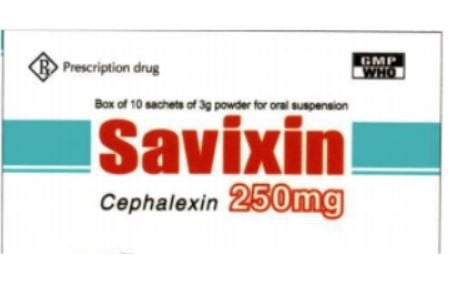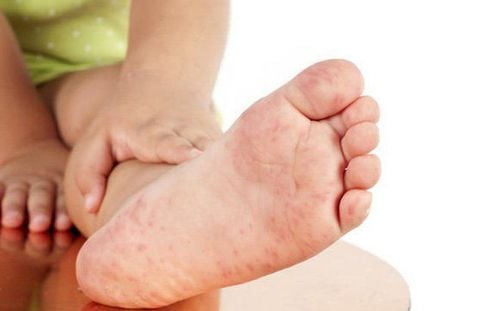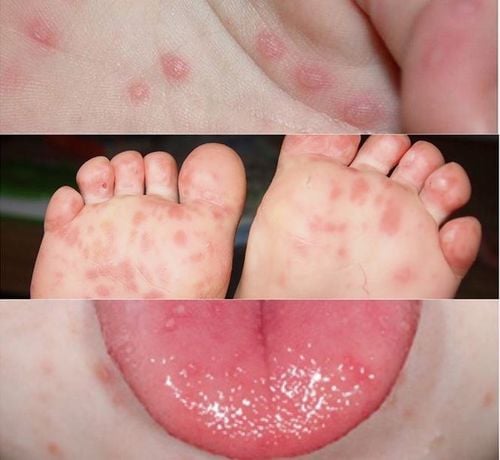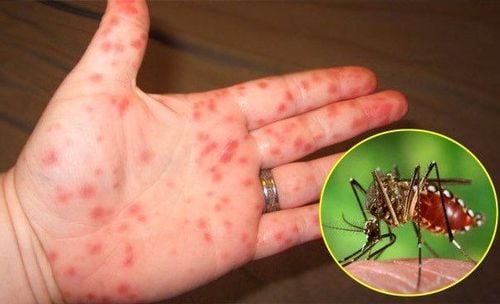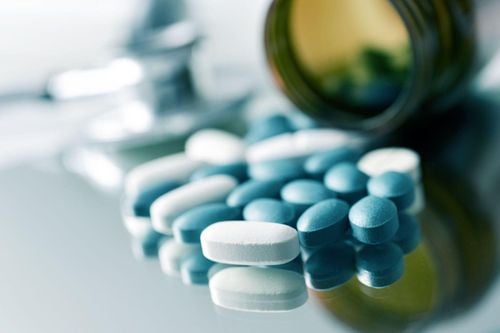This is an automatically translated article.
Hand, foot and mouth disease is a common disease in children under 5 years old, characterized by fever, sore throat, and blisters concentrated on hands, feet and mouth. The disease causes many dangerous complications that can be fatal if not treated promptly.1. What is hand, foot and mouth disease?
Hand, foot and mouth disease is an infectious disease that spreads from person to person that can develop into hand, foot and mouth disease caused by enteric viruses. The cause of the disease is caused by two groups of agents: Coxsackievirus A16 and Enterovirus 71 (EV71). The main manifestation of the disease is skin and mucosal lesions in the form of blisters concentrated on the mucous membranes of the mouth, palms, feet, buttocks, knees
Hand, foot and mouth disease is transmitted mainly by gastrointestinal tract from saliva, blisters. and feces of infected children. Therefore, factors of collective activities such as children going to kindergartens and kindergartens, where children play together are risk factors for disease transmission and outbreaks of outbreaks.
Hand, foot and mouth disease can occur all year round. However, the disease tends to increase and from March to May and from September to December every year. The disease can cause many dangerous complications. Severe complications are usually caused by EV71. These complications include:
Brain complications such as: encephalitis, brain stem inflammation, encephalitis, meningitis. Manifestations such as startling, somnolence, restlessness, unsteady gait, limb tremor, reverse vision, nystagmus, limb weakness, convulsions, coma,... Cardiovascular and respiratory complications include : Myocarditis, acute pulmonary edema, hypertension, heart failure, cardiovascular collapse can quickly die if not handled promptly.
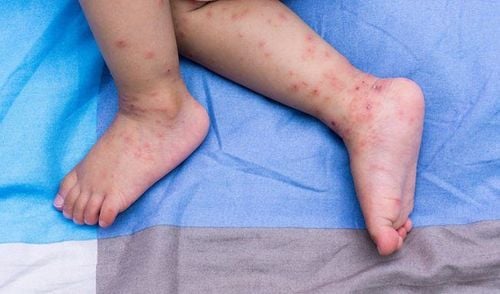
Bệnh tay chân miệng do virus đường ruột gây ra
2. Diagnosis of hand, foot and mouth disease
Diagnosis is based on clinical and subclinical symptoms, specifically:
Clinical symptoms:
Onset within 1 to 2 days with mild fever, fatigue, sore throat, anorexia, diarrhea Full-blown stage: Lasts 3-10 days with typical symptoms of the disease such as mouth ulcers: Red sores or blisters appear on the oral mucosa, gums, tongue, mouth sores leading to children refusing to eat or quit eating. suckling, increased salivation, crying baby. Skin rash like blisters: The site appears on the palms, soles, knees, buttocks, lasts about 1 week, then will leave bruises, very rarely ulcers or superinfections. Systemic manifestations such as: mild fever, vomiting, if the fever is high, it is necessary to pay attention to possible complications. Remission phase: Usually 3-5 days later, the child recovers completely if there are no complications. Subclinical diagnosis of the disease: To accurately diagnose the disease, it is necessary to perform RT-PCR test or isolate the virus to diagnose the cause
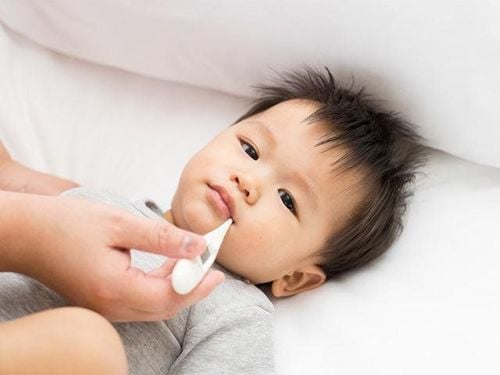
Trẻ sẽ bị sốt khi mắc bệnh chân tay miệng
3. Hand, foot and mouth treatment
Principles of treatment:
Currently, there is no specific medicine to treat hand, foot and mouth, so it mainly treats symptoms and improves children's resistance. Monitoring for early detection and early treatment of complications. Ensure adequate nutrition, improve the health of children. Specific treatment:
Clean oral hygiene for children Children need to rest, avoid stimuli Symptomatic treatment such as: Reduce fever for children: When the child has a high fever of 38.5 degrees Celsius or more, it is necessary for the child Take paracetamol or ibuprofen immediately. Rehydrate with oresol electrolyte solution. If you have mouth ulcers: Use glycerin borate solution to wipe your mouth before and after eating. Mouthwash gel is antibacterial and pain reliever to help children eat and drink easier. If there is a convulsion, it is necessary to use anticonvulsant drugs. Supplement with vitamin C, zinc, drugs to strengthen the child's resistance to quickly recover. It is necessary to return to the doctor as soon as there are signs such as: High fever ≥ 390C. Rapid breathing, difficulty breathing, fatigue Startling, fussy, trouble sleeping Vomiting profusely Unsteady feet Pale skin, purple veins, cold hands and feet, sweating Convulsions, coma If the child has serious symptoms, it should be treated intensive treatment, the intensive care unit according to indications. Need to be monitored pulse, temperature, blood pressure, breathing rate, breathing pattern, consciousness, rales, pulse...
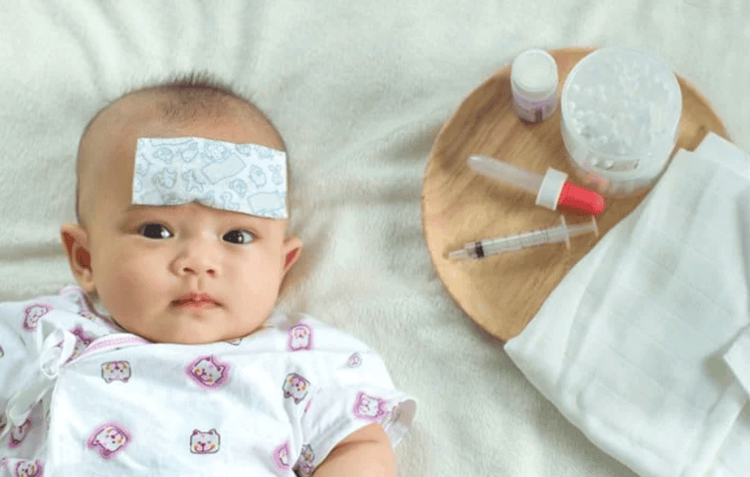
Cần hạ sốt cho trẻ để ngăn ngừa biến chứng
4. Hand, foot and mouth disease prevention
If you are in an epidemic area, the most effective measure to prevent the epidemic is to prevent the spread of the disease to healthy people by measures such as:
Limit contact with patients if not really necessary Isolate sick children at home: Do not go to kindergartens, schools, places where children play together in the first 10-14 days of illness. Children who show signs of fever in epidemic areas should be closely monitored, if suspected, they should be isolated. blisters and blisters on the patient's skin to avoid superinfection. Hygiene of living environment: Wipe the patient's room, disinfect surfaces, beds, and wards with Chloramin B 2%. Dispose of patient waste, clothing, bed linen, and reusable care equipment according to procedures to prevent gastrointestinal disease. Family members or medical staff need to wash their hands with soap after changing clothes, diapers, after coming into contact with feces, saliva, after examination... Children in the period from 6 months to 3 years old are very common. respiratory problems, respiratory infections and gastrointestinal infections if the baby is introduced to solid foods early or the storage and preparation of milk is not guaranteed. In particular, during this period, children may be slow to speak, slow to move... so parents need to pay special attention to caring for and providing adequate nutrition for children. The pediatric department at Vinmec International General Hospital is the address for receiving and examining diseases that infants and young children are susceptible to: viral fever, bacterial fever, otitis media, pneumonia in children. ,... With modern equipment, sterile space, minimizing the impact as well as the risk of disease spread. Along with that, Vinmec has a general examination in conjunction with a nutritionist to develop separate menus for the baby (if needed), specialists in neurological examination will help advise and treat the baby about the following diseases. mental problems and children's reflexes: waiting, practicing speaking, speaking fluently, ..
Vinmec International General Hospital with a system of facilities, modern medical equipment and a team of experts, With many years of experience in medical examination and treatment, parents can rest assured that their baby will be examined and treated at the Hospital.
Please dial HOTLINE for more information or register for an appointment HERE. Download MyVinmec app to make appointments faster and to manage your bookings easily.
SEE MORE
Medicines to help treat hand - foot - mouth disease in children How long does hand, foot and mouth disease in children go away? What to abstain when your child has hand, foot and mouth disease?





